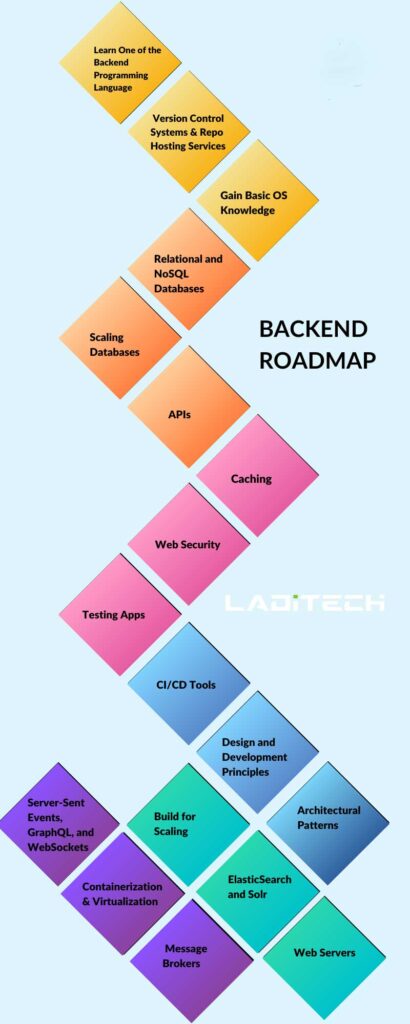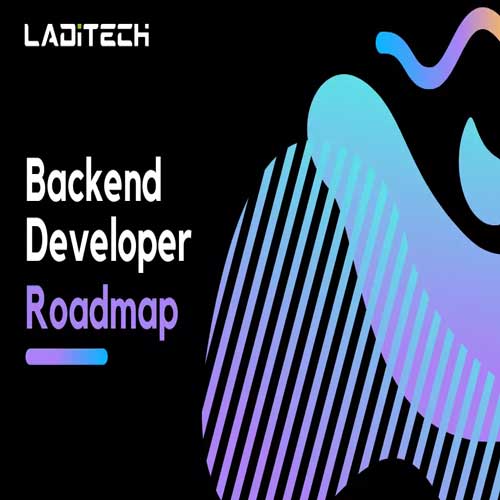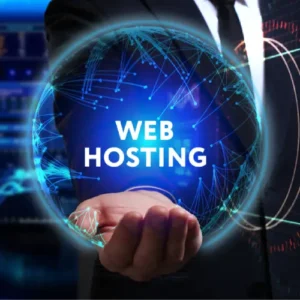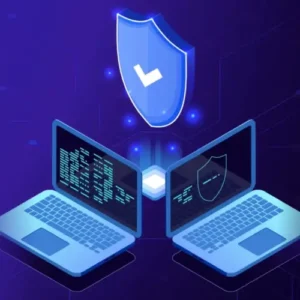Roadmap for Backend Developers in 2023. It is hard to exist in today’s digital world without the internet and web or native apps. Websites require at all times, from performing financial transactions to browsing for things.
Furthermore, every online application appears to give a simple and smooth user experience. But have you ever considered how it works so precisely?
Web development is made up of two parts: the front end and the back end. The front end manages the appearance and feel of the website, while the back end handles its functional and technical aspects.
Companies also engage professional developers to design web app and guarantee that it works properly.
That being said, if you’re looking for information about backend development. You’ve come to the correct spot.
How?
It’s because we’re going to discuss backend development. The responsibilities of a backend developer, and the path to becoming one in this blog.
Now let’s get started with the fundamentals.
Backend Development Overview
Roadmap for Backend Developers in 2023. Back-end development is the process of working with databases, servers, and APIs to connect the front-end and back-end of an application to complete various activities. The logic, operations, and integration of server-side web applications are all covered by the backend.
Top Security Practices for Node.js
Backend development jobs involve building libraries and APIs, as well as dealing with front-end system components.
Simply said, the back-end is the inverse of the front-end, which deals with the appearance and feel of the web app, as the back-end performs all duties that conceal from users.
Backend Developer Duties and Responsibilities
Now that you’ve learned about backend development, let’s look at the duties and responsibilities of a backend developer.
Why Choose NodeJS For IoT Applications?
Below is a list of the duties that a backend developer must perform:
- Making updates and modifications while keeping an eye on the web app’s operation.
- Compile and evaluate data, procedures, and codes to discover opportunities for improvement and eliminate mistakes.
- Data collection and reporting to team leaders and clients.
- For a better user experience, create more useful designs, specify objectives, and produce high-quality code.
- Providing assistance across the complete system development life cycle.
- Creating automation tools.
- Working in an agile environment while integrating APIs.
- Configuring server-side tools and technologies.
- Before sending queries to the database, data is validated.
A Plan for Becoming a Backend Developer in 2023
Roadmap for Backend Developers in 2023. With a better grasp of backend development and backend developer duties, we can go on to learn about the roadmap you must follow if you want to become a backend developer.
Here’s a step-by-step guide to become a backend developer.
Discover a Back-End Programming Language
Both front-end and back-end development need a distinct set of abilities. When we think of front-end programming languages, the three most common that spring to mind are HTML, CSS, and JavaScript.
Similarly, in order to become a backend developer, you must first master one of the server-side programming languages.
Java, Python, C#, Ruby, Rust, Go, and PHP are some programming languages to consider.
Discover a Back-End Programming Language
Both front-end and back-end development need a distinct set of abilities. When we think of front-end programming languages, the three most common that spring to mind are HTML, CSS, and JavaScript.
Similarly, in order to become a backend developer, you must first master one of the server-side programming languages.
Java, Python, C#, Ruby, Rust, Go, and PHP are some programming languages to consider.

Learn the Fundamentals of Operating Systems
Operating systems, such as Windows, Linux, Unix, or iOS, are programs that oversee the distribution of computer resources among various programs. Input/output devices, computer memory, CPU, and network connections are examples of these resources.
To be a backend developer and make your work easier, you must understand concepts such as terminal usage, POSIX fundamentals, terminal commands, how the operating system works, memory management, networking concepts, threads and concurrency, I/O management, interprocess communication, and process management.
Understand Relational and NoSQL Databases
A relational database is built on a relational data model, which divides information into rows and columns (table). It saves and makes available data points that connects to one another.
NoSQL (not merely SQL) databases are non-tabular databases that do not store data in rows and columns. It is available in a number of data model formats, including key-value, documents, graphs, and wide-column, to provide a versatile and easy-to-scale schema capable of handling massive amounts of data and user traffic.
Discover How to Scale Databases
Scaling refers to changes made to the size of the database system to suit anticipated demands. Working as a backend developer and becoming interested in databases necessitates understanding how to scale databases.
Data Replication, Sharding Techniques, Database Indexes, and the CAP Theorem are some prominent methods for scaling databases.
Aside from scalability, you will need to understand ACID, ORMs, N+1 Issues, Transactions, Failure Modes, Normalization, and Profiling Performance while dealing with a database.
Understand APIs
Application Programming Interfaces (APIs) serve as a bridge between two application services, allowing them to interact via a set of protocols and specifications.
Additionally, as a backend developer, mastering APIs will assist you in connecting the front-end of the web app with the back-end to improve functionality and user experience. HATEOAS, Authentication (OAuth, Token Auth, OpenID, Cookie Based, SAML, JWT, etc.), Open API Specifications, and other API principles are important to comprehend.
Forecasts and Trends for the Future of Software Development
REST, SOAP, JSON APIs, GraphQL, and gRPC are some of the major API alternatives for software development.
Caching fundamentals explained
Cashing is the act of keeping frequently used data in a device’s local memory for a specified amount of time in order to rapidly access the information held in the database. The major advantage of caching is that it reduces the processing load for improved performance.
When it comes to server-side web app development, Redis and Memcached are two prominent caching options.
Learn About Web Security
Because the web is one of the most vulnerable cyberattack vectors, web security is an essential component of every online program or website. As a backend developer, knowing web security protection measures will help you keep your online application safe from cyber attacks.
Some online security principles to be aware of include hashing algorithms, CORS, HTTPS, SSL/TLS, OWASP Hazards, Server Security, and Content Security Policy.
App Testing Methods
Testing is the key to developing web apps that meet client and user requirements while avoiding code and bugs. Software testing informs developers if they are on the correct road or whether changes require.
Integration testing, functional testing, and unit testing are some of the most often used software testing approaches.
CI/CD Instruments
Continuous Integration/Continuous Deployment (CI/CD) is the process of automating the integration of code changes, building, testing, deploying, and delivering applications in order to provide rapid release of software updates in production.
Jenkins, CircleCI, GitlabCI, Bamboo, and other prominent CI/CD tools list here.
Understand the Fundamentals of Design and Development
Design and development ideas such as GOF (Gang of Four) Design Patterns, Test Driven Development, Domain Driven Development, Event Sourcing, and CQRS are also important to understand if you want to become a backend developer.
Recognize Architectural Patterns
Architectural patterns are common, repeatable solutions to iterative groups of issues within a software architecture, such as performance restrictions, business risk mitigation, and availability.
Monolithic, Service Oriented, Microservices, Service Mesh, and Serverless are some of the most often utilized architectural patterns for web app development that you should be aware of.
Aside from that, you must be aware of the twelve-factor technique used for designing, growing, and managing SaaS programs as a backend developer.
Discover ElasticSearch and Solr
ElasticSearch is a distributed search and analytics engine that saves data in order to give rapid, highly relevant search results, as well as strong analytics for detecting trends and patterns in data.
Apache Solr, on the other hand, is an open-source search engine that provides strong searches, real-time indexing, database integration, dynamic clustering, documentation handling, and so on.
Understanding about ElasticSearch and Solr as a backend developer would be beneficial when integrating search engines into the web project.
Recognize Message Brokers
Message brokers serve as the foundation of message-oriented middleware. They transform a message from the format of the sender’s messaging protocols to the format of the receiver’s formal messaging protocol.
You may use a message broker to provide a common integration mechanism to accommodate various architectural patterns. Apache Kafka and RabbitMQ are two popular message brokers that you should be familiar with.
Recognize the Differences Between Containerization and Virtualization
As a newcomer, it’s easy to mix up between containerization and virtualization because both allow different workloads to operate on a single host. They differ in isolation, security, deployment, operating system, persistent storage, networking, load balancing, and other areas.
Discover Server-Sent Events, GraphQL, and WebSockets
Server-sent events, GraphQL, and WebSocket are some more technologies that a backend developer should be familiar with.
Although SSE allows the web server to send data to the user in real time over an HTTP connection. GraphQL provides a runtime to complete API requests with existing data, and web sockets allow the client and server to exchange data at the same time.
Recognize Web Servers
A web server is a piece of hardware and software that takes HTTP/HTTPS requests, processes them, and displays the results in web page formats. MS ISS, Apache, Nginx, and Caddy are some of the leading web servers among backend engineers that you should also learn about.
Build for Scalability
It is your obligation as a backend developer to design a system that is readily scalable and can tolerate spikes in user traffic. In order for a system to be scalable. You must consider observability, coupling, infrastructure, mitigation techniques, scaling type, monitoring, instrumentation, telemetry, and the software application’s evolvability.
Conclusion
That concludes our discussion about backend development and how to become a backend developer. We hope you found this information helpful as you begin your career as a backend developer.
Moreover, if you are a company owner looking to employ an experienced backend developer to work on your project, contact the LadiTech team of professionals, explain your concept, and receive a tailored project development quotation.










